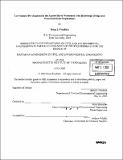| dc.contributor.advisor | Peter Shanahan. | en_US |
| dc.contributor.author | Friedlich, Brian J. (Brian Joseph), 1982- | en_US |
| dc.contributor.other | Massachusetts Institute of Technology. Dept. of Civil and Environmental Engineering. | en_US |
| dc.coverage.spatial | n-us-ma | en_US |
| dc.date.accessioned | 2006-02-02T18:49:58Z | |
| dc.date.available | 2006-02-02T18:49:58Z | |
| dc.date.copyright | 2005 | en_US |
| dc.date.issued | 2005 | en_US |
| dc.identifier.uri | http://hdl.handle.net/1721.1/31118 | |
| dc.description | Thesis (M. Eng.)--Massachusetts Institute of Technology, Dept. of Civil and Environmental Engineering, 2005. | en_US |
| dc.description | Includes bibliographical references (leaves 83-85). | en_US |
| dc.description.abstract | Low-Impact Development (LID) is a relatively new approach to stormwater management. It aims to mimic natural hydrology through increased recharge and decreased runoff. LID technologies focus on distributed treatment of stormwater, as opposed to traditional centralized management. The potential benefits include improved water quality in runoff, decreased flooding in rivers and streams, and increased baseflow critical to surface water quality. This thesis investigates two important aspects of any new stormwater management technology: the site level design and large-scale implications. A case study for site-level design is performed in the town of Acton in central Massachusetts. An LID stormwater management design is completed on a three-acre site. The design implements LID technologies, such as rain garden storage areas, pervious pavement, and curb cuts. Pre-developed, existing, and LID-designed scenarios are analyzed. A computer program called the Site Low-Impact Development Design (SLIDD) Model is developed to account for the distributed nature and unique characteristics of the LID technologies. Analysis reveals that LID is capable of not only improving the existing site hydrology, but returning a developed site to natural hydrologic conditions. The design is able to control both peak runoff rates and runoff volume. The watershed-scale implications of LID are of great importance, especially as implementation of such technologies increase. The potential benefits are analyzed using a water balance model of the Upper Nashoba Brook Watershed in Massachusetts. It is observed that LID implementation on a large scale can improve baseflow during critical summer low-flow months. | en_US |
| dc.description.abstract | (cont.) It is also noted that LID can decrease flooding through the reduction of overland flow and interflow. The importance of using progressive stormwater management techniques like LID in the further development of the area is highlighted by an analysis of the decline of baseflow to zero during summer months with increased development. While the benefits strongly support LID, several concerns are noted. Both the decrease of ground water quality through increased recharge of contaminated stormwater and potential economic and logistic concerns of an increasing water table are potential liabilities of LID. The conditions under which LID could cause these problems are discussed, as well as potential solutions. | en_US |
| dc.description.statementofresponsibility | by Brian J. Friedlich. | en_US |
| dc.format.extent | 96 leaves | en_US |
| dc.format.extent | 5994683 bytes | |
| dc.format.extent | 6005667 bytes | |
| dc.format.mimetype | application/pdf | |
| dc.format.mimetype | application/pdf | |
| dc.language.iso | eng | en_US |
| dc.publisher | Massachusetts Institute of Technology | en_US |
| dc.rights | M.I.T. theses are protected by copyright. They may be viewed from this source for any purpose, but reproduction or distribution in any format is prohibited without written permission. See provided URL for inquiries about permission. | en_US |
| dc.rights.uri | http://dspace.mit.edu/handle/1721.1/7582 | |
| dc.subject | Civil and Environmental Engineering. | en_US |
| dc.title | Low-impact development in the Assabet River Watershed : site hydrologic design and watershed-scal implications | en_US |
| dc.type | Thesis | en_US |
| dc.description.degree | M.Eng. | en_US |
| dc.contributor.department | Massachusetts Institute of Technology. Department of Civil and Environmental Engineering | |
| dc.identifier.oclc | 61161983 | en_US |
